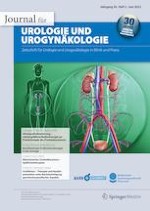Anzeige
05.05.2023 | Originalien
Urolithiasis – Therapie und Rezidivprävention unter Berücksichtigung geschlechtsspezifischer Aspekte
Erschienen in: Journal für Urologie und Urogynäkologie/Österreich | Ausgabe 2/2023
Einloggen, um Zugang zu erhaltenZusammenfassung
Die Prävalenz der Urolithiasis nimmt weltweit bei beiden Geschlechtern stetig zu. Ernährung und Lebensstil, wie die zunehmende Prävalenz der Adipositas und weitere Komponenten des metabolischen Syndroms, gelten als Schlüsselfaktoren für diese Entwicklung. Geschlechtsspezifische Unterschiede als Ergebnis der interventionellen Therapie der Urolithiasis wurden bisher nicht beobachtet. Iatrogene Verletzungen der männlichen Harnröhre gelten jedoch als häufigster Grund für Harnröhrenstrikturen nach endourologischer (Stein)therapie. Dagegen wird eine Sepsis, als Hauptursache der harnsteinbedingten Mortalität, nach Ureterorenoskopie und perkutaner Nephrolithotomie häufiger bei Frauen konstatiert. Zudem bestehen Unterschiede in der Häufigkeit verschiedener Steinarten zwischen Männern und Frauen. Kalziumoxalat- und Harnsäuresteine werden häufiger bei Männern beobachtet, während Karbonatapatit und Struvit bevorzugt bei Frauen diagnostiziert werden. Die Harnsteinanalyse ist daher die wichtigste Voraussetzung für eine erfolgreiche Rezidivprävention. Die Diagnostik richtet sich nach der Zuordnung der Patienten zur Niedrig- oder Hochrisikogruppe. Die ernährungsmedizinischen und pharmakologischen Maßnahmen zur Therapie der jeweiligen Steinart orientieren sich dabei an den Risikofaktoren im 24-h-Harn. Ein personalisierter Ansatz, der geschlechtsspezifische Unterschiede berücksichtigt, könnte Therapie und Entscheidungen zur Rezidivprävention von Harnsteinen weiter verbessern.
